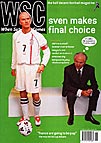 Aside from the chevron on their shirts, Filippo Ricci explains that Sampdoria are now unrecognisable from the team that came so close to European glory just a decade ago
Aside from the chevron on their shirts, Filippo Ricci explains that Sampdoria are now unrecognisable from the team that came so close to European glory just a decade ago
On April 21, Sampdoria lost 2-0 at home to Serie B’s bottom club, Crotone, a team from a tiny town in Calabria. The result left the once-mighty club just four points above the relegation zone with six games to go. Ten years ago, Sampdoria lost the last the European Cup final before the start of the Champions League, 1-0 to Barcelona at Wembley. On paper, it’s a long journey, on the pitch, a quick and irreversible plunge.
The 1992 final was Sampdoria’s third European final in four years, having lost 2-0 to Barcelona in 1989 and beaten Anderlecht by the same score a year later, both in the Cup-Winners Cup. The Wembley match was an eventful one, dominated by the Catalans but also notable for three costly misses by Gianluca Vialli. Barcelona won thanks to a Ronald Koeman free-kick eight minutes from the end of extra time.
That was the best team Sampdoria ever had, with Gianluca Pagliuca in goal, a defence including Pietro Vierchowod and Srecko Katanec (now coach of Slovenia), with Attilio Lombardo, Fausto Pari, Toninho Cerezo and Ivano Bonetti in midfield, and Vialli and Roberto Mancini up front. Thirty thousand fans made the trip from Genoa to see an era come to an end. In the summer, the veteran Yugoslav coach Vujadin Boskov left, to be replaced by Sven-Goran Eriksson. Vialli went too, as did Cerezo and Pari.
Eriksson tried to rejuvenate the team, bringing in Des Walker, Vladimir Jugovic and Enrico Chiesa, but Sampdoria failed even to qualify for Europe. In the past this would not have been any cause for despair. Before 1989 the club, created by a merger in 1946, had had just two seasons in Europe, and had waited 23 years for a second chance after their Fairs Cup debut in 1962.
When the oilman Paolo Mantovani was installed as chairman in 1979, Sampdoria were struggling in Serie B. Under his stewardship they went up in 1982 and embarked on a triumphant decade. But midway through Eriksson’s second season, after more millions had been spent on the likes of David Platt and Ruud Gullit, Mantovani died. Signs of decline were not immediately visible as his son Enrico took over – the team finished third and won the Cup – but in fact the downhill slide had begun.
While Paolo Mantovani had been loved by the fans, they did not have the same faith in his son and his daughter Stefania, who also became involved in the club. More big names arrived in 1995-96, including Clarence Seedorf, Christian Karembeu and Enrico Chiesa, for his third spell. The following year, a team including Juan Sebastian Verón, discovered at Boca Juniors, reached the UEFA Cup final. But then Eriksson left for Lazio, taking with him Mancini, the idol of the Curva Sud and as much a symbol of the winning days as Paolo Mantovani.
The supporters’ relationship with Enrico Mantovani began to sour. From now on, there would be one mistake after another. The new coach was Cesar Luis Menotti, by then a pale shadow of his former self. He lasted just nine games before Enrico recalled Boskov. His magic did not return, despite the presence of Giuseppe Signori, an ageing Jürgen Klinsmann and even Daniele Dichio, signed on a free from QPR.
Sampdoria’s 1998-99 season began on July 4, as they became the first Italian club to enter the Intertoto Cup. It finished almost a year later, with the Blucerchiati back in Serie B. The coach at the end was Luciano Spalletti, sacked and then recalled to oversee the brief and unsuccessful reign of David Platt, whose appointment had been opposed by the Italian Manager’s Association as he lacked the right qualifications.
Three years later, Sampdoria are still there. Enrico Mantovani has been forced out by the fans, who made his life impossible. The only consolation for the Sampdoriani is that city rivals Genoa, historically the larger club, are facing a similar crisis. The Genoan derby is still colourful and passionate, but these days it has an air of sadness too. On April 8, a sell-out crowd of over 40,000 yawned its way through a 0-0 draw, a result which had been widely tipped. Both sides needed the point. At the moment, neither can afford to risk losing.
From WSC 184 June 2002. What was happening this month